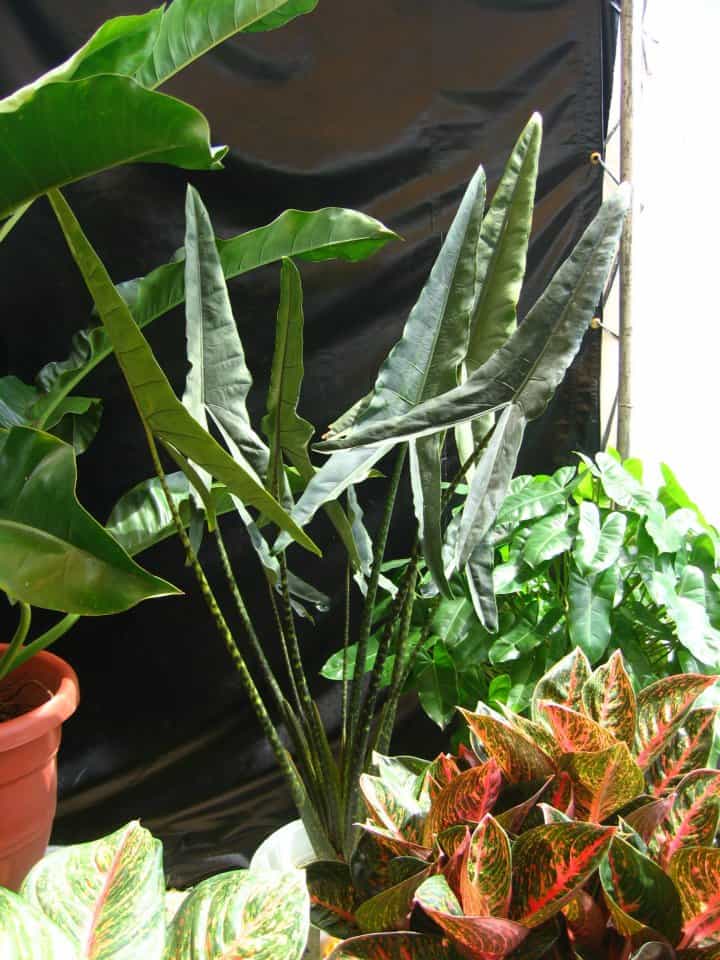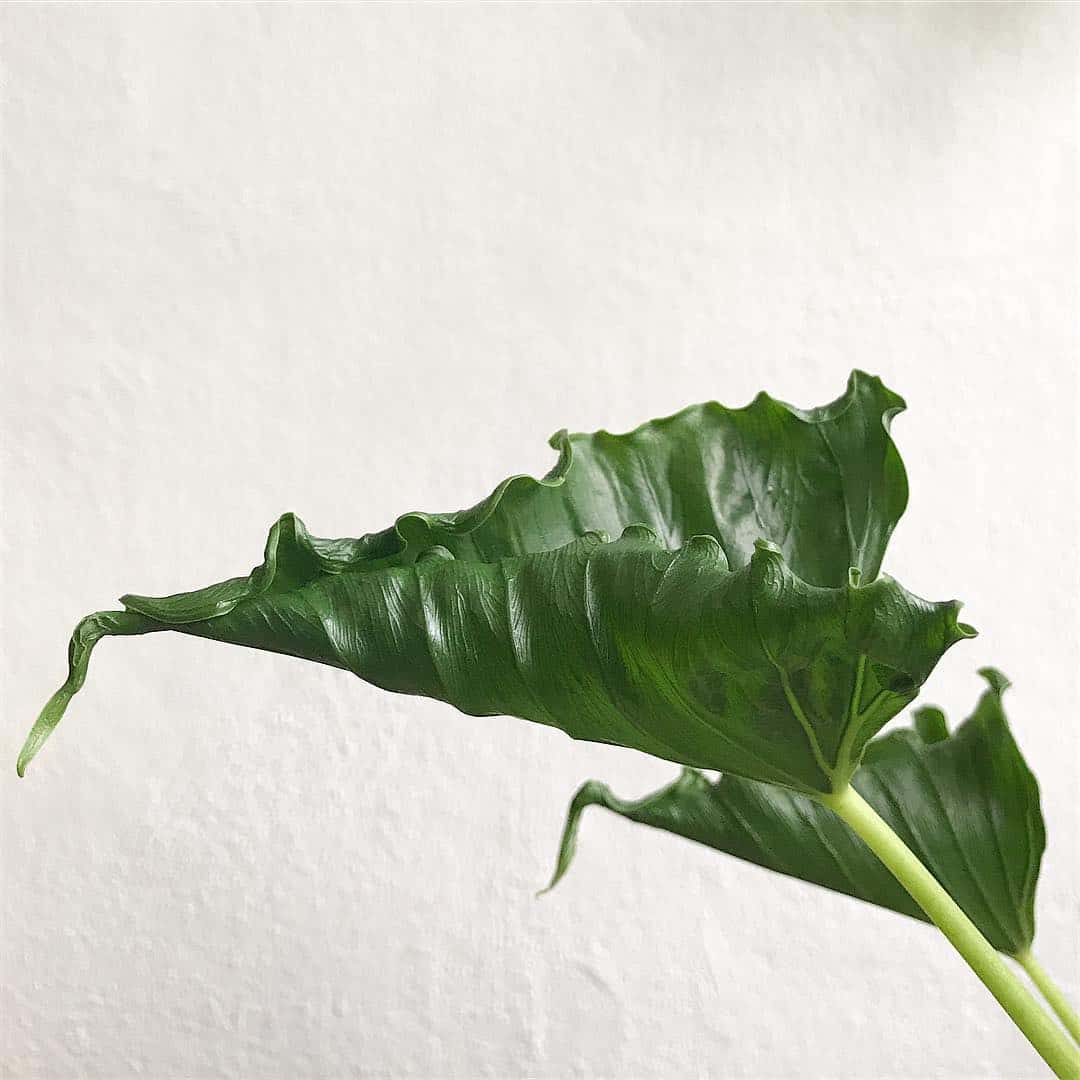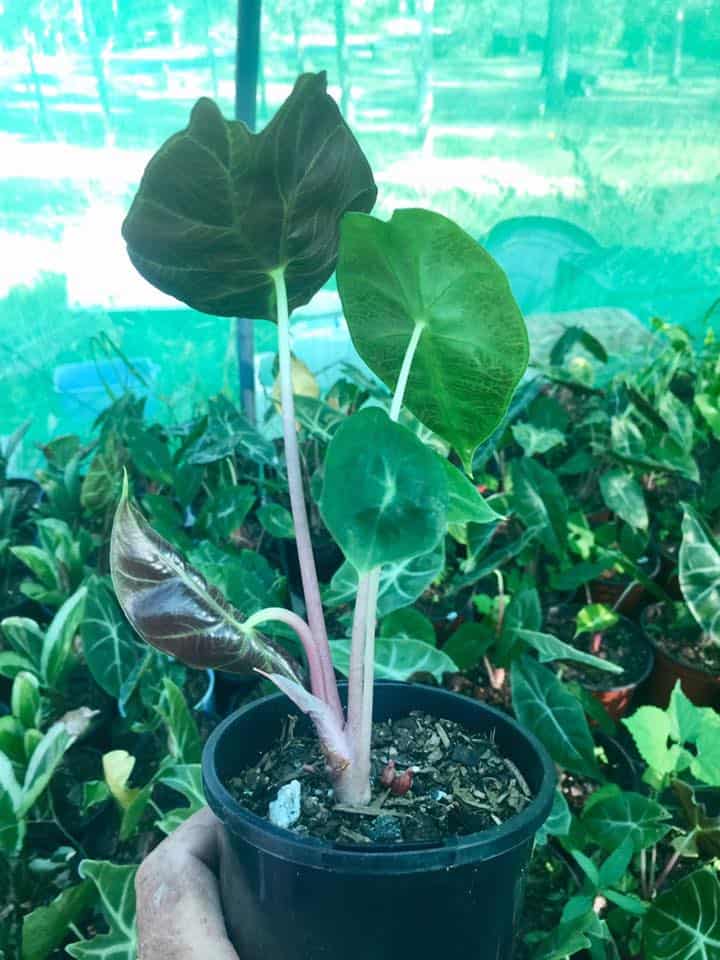Alocasia is famous for its beautiful leaves and has wide varieties you can choose from.
Here, we will look at 19 varieties of Alocasia plants and give you a helping hand in choosing the Alocasia of your preference.
Table of Contents Show
15+ Beautiful Alocasia Varieties You Can Grow
Among those 97 species following 19 varieties are conventional, elegant, and handy. Also, they have striking foliage in terms of texture, shape, size, and color.

Any one of these plants would serve as a fantastic decor with some extra-terrestrial edge.
1. Alocasia Amazonica
Common Name: Alocasia Polly
One famous Alocasia variety, Alocasia amazonica, is a hybrid between Alocasia longiloba x Alocasia sanderiana.
The centerpiece of Alocasia amazonica is its deep green leathery leaf. The leaves are arrow-shaped or heart-shaped, with wavy edges and thick white veins running throughout the leaves.

The leaves can get as long as 16 inches. At the same time, the mature plant can grow up to 1 to 2 feet tall and wide.
Alocasia Amazonica flowers have a flowering spadix that looks like a long spike.
If your plant starts looking unwell, let it stay outside in the shade for its growing season. Contrary to its name, this plant is found in Southeast Asia and does best in USDA zones 10-12.
2. Alocasia Micholitziana ‘Frydek’
Common Name: Green Velvet
Talking about the features, Micholitziana Frydek somewhat resembles Amazonica. But you can easily distinguish it by the texture of the leaves.
It has striking green-colored arrow-shaped leaves with a soft velvety texture.
Unlike most other Alocasia plants, this plant does not have stretchy white veins. The veins are narrower and less prominent than the leaves of Amazonica.
The leaves of Alocasia Green Velvet can grow up to 18 inches long, while the whole plant can measure about 2 to 3 feet in height.
They rarely bloom indoors, and they are not famous for their flowers. Blossoms are spadix or spathe types.
3. Alocasia Zebrina
Common Name: Zebra plant
Alocasia Zebrina is native to tropical and temperate parts of Southeast Asia.
As the name suggests, this plant has a distinct yellow and black colored zebra-striped pattern on its stems.

This unique, long, and thin stem uphold big leaves. The leaves are primarily glossy, dark green in color, and heart-shaped.
A mature Alocasia Zebrina can grow up to 3 feet tall and wide. They flower rarely, and the spadix has small whitey-greenish flowers.
Their USDA growing zone is zones 10-11.
4. Alocasia Reginula
Common Name: Black Velvet
This plant is native to the jungles of Borneo in Southeast Asia.
Alocasia Black Velvet is the common name of Alocasia Reginula. This plant is a dark horse among all the Alocasias featuring its elegant black leaves with white veins.
The veins can be of different colors, like pale green or silver. The ‘succulent-like’ leaves are heart-shaped and thick.
The leaves can grow about 6 inches long, and their width can be about 2.5 inches.
This plant rarely blooms a white flower that is not appealing to the eyes. Their preferred USDA zone is 9b to 11.
5. Alocasia Rugosa
Scientific Name: Alocasia Melo
Alocasia rugosa hails from the rocky terrain of Southeast Asia. They prefer USDA zones 10-11.
The leaves of this plant are yellowish-green in color and have a wrinkly, rough texture.
Their leaves grow on upright light green petioles attached to the stem. The veins are quite visible, although they are the darker version of the leaf color.
Leaves are shaped like an arrowhead and can grow up to 50cm in length and 25cm in width. The plant is not much of a grower and can grow up to 2 feet in height with an equal spread.
Rugosa produces a few off-white colored flowers that have no fragrance.
6. Alocasia Baginda
Common Name: Dragon Scale
Dragon Scales belong to the warm tropical forests of Borneo, the third-largest island in the world.
The leaves are emerald green, and the veins are prominent and have a dark shade, making them look like dragon scales.
Leaves are oval and can grow up to 2 feet in length. The plant can grow up to 3 feet long and 1.5 feet wide.
This plant grows purple spathe flowers that don’t come close to the elegance of the foliage.
Their preferred UDSA zone is 9b – 11 outdoors and 4b – 11 indoors in their growth zone.
7. Alocasia Macrorrhiza ‘Stingray’
Common Name: Elephant Ear Stingray
Alocasia macrorrhiza originated from Southeast Asia and has been cultivated in the Philippines for a long time.
Macrorrhiza looks like a stingray as this plant has a decorative tail and wings-like structure. The leaves stretch outward and point upward.

Their leaves are emerald green and look like ribbed leather. The leaves of indoor varieties don’t grow as significantly as other Alocasia varieties but are big nonetheless.
The plant can grow up to 6 feet tall and 3 feet wide in its natural habitat. This plant rarely blooms a green-colored flower.
If you want to keep this plant outside, you should be in hardiness zone 10-11, or you can grow it indoors in all zones.
8. Alocasia Cucullata
Common Name: Hooded Dwarf
Like most Alocasia varieties, Alocasia cucullata, or hooded dwarf, originated from Southeast Asia with primary roots in China.
The leaves, roughly 40cm long and 28cm wide, are shaped like a heart. They have four prominent veins which run from the center to the edge of the leaves.
The petioles can grow up to 85cm, and the stem is 3-6cm thick.
It can externally be used as a traditional Chinese medicine to treat snakebites, rheumatic disorders, joint disorders, and pus buildups inside the body.
The plant can grow up to a height of 90cm, and the leaves can be up to 2 meters long. It blooms white/cream-colored flowers during summer.
Its hardiness zone is 7b to 10b. This plant flourishes the most when kept indoors.
9. Alocasia Portodora
Common Name: Portodora
Alocasia Portodora belongs to the tropical rainforests of Southeast Asia. They have intimidating, ribbed leaves that resemble giant fans.
The green giant leaves that point upward can grow up to 90cm in length. This plant grows to its full extent, up to 4 meters, in its natural habitat.
That is huge for your living room! Since Portodora can grow up to 160cm tall and go up to 90cm wide.
This plant’s preferred hardiness zone is 8-11.
10. Alocasia Triangularis
Common Name: Triangular Alocasia
Alocasia Triangularis hails from Eastern Australia and Asia’s subtropical and tropical regions.
True to their name, the leaves of this plant do resemble diamonds. The edges of the leaves are wavy and curled.

The leaves have a maximum growth of 30cm, less for a plant in the Alocasia family.
However, that is balanced by the size of the stem. The plant, much like other varieties of Alocasia, can grow up to 90cm in length.
The plant flourishes well in USDA zone 11.
11. Alocasia Sanderiana
Common Name: Kris plant
Like almost all Alocasia varieties, the Kris plant also hails from Southeast Asia. It mainly belongs to Northern Mindanao, Philippines.
This plant is rare, and IUCN lists this Alocasia Sanderiana as ‘Critically Endangered.’ Harvesting this plant is illegal in some countries.
The leaves of this plant exhibit a shiny dark green to greenish-black color with very prominent yellowish veins. You can usually see a purplish-to-red color on the back of the leaves.
The beautiful leaves are arrowhead-shaped, represent a double-edged Filipino sword Kalis, and are up to 40cm in length and 20cm in width.
The plant can grow up to 60cm in length and produce a cluster of creamy-white flowers covered by a white and green spathe.
Their USDA hardiness zone is 10-11.
12. Alocasia Wentii
Common Name: Hardy elephant ears
Alocasia wentii belongs to the tropical rainforests of Southeast Asia. This plant is a cross between Alocasia odora and Alocasia gageana.
Like most of the leaves in the Alocasia genus, the leaves of this plant look like elephant ears. The mesmerizing part of this plant is the color of its leaves.
The top side is glossy green, and the underside of this plant’s leaf displays magnificent purplish color. Its leaves can grow up to 30.5 cm in length.
A mature wentii can grow up to 60cm long and 50cm wide, producing short-lived pale spathes.
Recommended USDA zone for this plant is zone 8b-10a.
13. Alocasia Morocco
Common Name: Elephant ear ‘Morocco’
This plant hails from the tropical rainforests of Southeast Asia.
This plant’s leaves are deep green, making the light yellowish leaves glow more. The tip is pointy and lean, representing an arrow.

Alocasia Morocco can grow big in a short time. This plant can grow up to 180 cm tall in its natural habitat.
It grows a greenish spadix that is not so pleasant to look at. Its preferred USDA zone is 10-11.
14. Alocasia Masquerade
Common Name: Mayan Mask
Like most plants in the genus Alocasia, the Mayan Mask is also native to Southeast Asia.
Alocasia Masquerade has elegant and magnificent arrow-shaped, grass-green leaves at the top and chocolatey burgundy color at the base.
The leaves are huge and can grow up to 60cm in length. The veins are prominent and light green, adding to the beauty of the leaves.
A mature Mayan mask can grow up to 180cm in length and 150cm in width. It produces greenish-yellow flowers during the summer season.
Its preferred USDA zone falls from 7 to 10.
15. Regal Shield
Scientific Name: Alocasia odora x Alocasia reginula
True to its name, this plant looks royal. Alocasia Regal Shield is a cross between Alocasia odora and Alocasia reginula.
The leaves are cordate-sagittate and have a single-leaf division. They have thick green leaves with a dark purple tint on the underside.
The visible veins are light green at the top and yellowish at the bottom.
The leaves can grow up to 23cm in length and 15.2cm in width. The entire plant can grow up to 120cm in height and 91cm in width.
This plant produces white/pale yellow flowers nearly 9cm in length and 2cm in diameter.
They have an acidic smell. Regal shield’s preferred USDA zone is 9-12. Regal Shield originates from Southeast Asia and Africa.
16. Alocasia Lauterbachiana
Common Name: Purple Sword
Alocasia Purple Sword has a different origin from the rest of the Alocasias and is originally from Papua New Guinea.
This plant’s long lance-like leaves are sure to grab your attention. The leaves are signature green in color and have wavy edges.
The leaves give you a glossy feel when they are young and waxy as the plant grows. This plant is called a Purple Sword because purple veins are visible in the center and under the leaves.
The sword-like leaves are up to 50cm long and 10cm wide, while the entire plant can grow up to 150 cm.
They produce greenish-white flowers with a spadix and spathe. They prefer the USDA hardiness zone 10-11.
Alocasia lauterbachiana is named after a German botanist Carl Adolf Georg Lauterbach.
17. Silver Dragon
Scientific Name: Alocasia baginda
You have read about Dragon Scale somewhere in the article above. Silver Dragon and Dragon scale both of them have the same scientific name.
But you can see the difference in their color. Silver dragon is more on the silver side, while dragon scale falls on the greenish side.
Silver dragon hails from the tropical rainforests in Southeast Asia.
The leaves of the silver dragon are exotic to look at. They look like elongated hearts and have velvety touch.
The whole plant can grow up to 50cm, and the bloom is piston-shaped and pale greenish-white.
Its preferred USDA zone is 10-11.
18. Alocasia Cuprea
Common name: Red Secret
Alocasia cuprea is native to South East Asia’s hot and high-humidity areas and lower canopies, especially Indonesia.
The leaves are oval-shaped and metallic reddish or greenish. The leaves look majestic, with strange veins and shadows along with them.
And there is something strange with the leaves. They seem to change color depending on which angle you see this plant.
The leaves alone can reach a size of up to 60cm. In comparison, the plant can go to a maximum of 100cm.
Their flower is something you won’t be proud of growing and are pale yellow in appearance.
Alocasia cuprea prefers USDA zone 9b -11.
19. Alocasia Longiloba
Common Name: Tiger Taro
Alocasia longiloba is native to most Southeast Asian countries like China, Malaysia, Singapore, etc.
Their leaves are huge and shaped like arrows. Their primary color is green, while silver and blue are secondary colors.

The leaves are 95cm long and 40cm wide, while the whole plant spans nearly 100cm.
The flowers of this plant are creamy-white and light green. They produce bright orange fruits occasionally.
Place them in a hardiness zone above 12; however, you can place them indoors in zones below that.
Some More Alocasia Varieties
| Alocasia Varieties | Growth Sizes | Features |
|---|---|---|
| Alocasia Macrorrhiza Variegata | Height: 15 feet Spread: 6 feet | Heart-shaped, yellowish-green spathe with a spadix with light green and white blotches color. |
| Alocasia Hilo Beauty | Height: 2 feet Spread: 3 feet | Vase-shaped, green leaves mottled with creamy yellow splotches color. |
| Alocasia Gaint Taro | Height: 15 feet Spread: 8 feet | Arrow-shaped, green leaves elephant, thick, prominently-veined, ruffled with solid green color. |
| Alocasia Nebula | Height: 2.46 feet Spread: 2.46 feet | Heart-shaped ,ovate leaves with a smooth satin texture with medium grey with darker areas color. |
| Alocasia Reversa | Height: 2 feet Spread: 1 feet | Arrow shaped ,stunning foliage with Green, Silver / Grey, Patterned color. |
| Alocasia Scalprum | Height: 0.98 feet Spread: 0.98 feet | Lance shape, thick and rubbery leaves with intricate venation with black in color. |
| Alocasia Infernalis | Height: 1.64 feet Spread: 1.64 feet | Arrow-shaped, clearly defined veins and beautiful dark with black color. |
| Alocasia Portei | Height: 6.5 feet Spread: 5 feet | Arrow-shaped, Massive, thick - stemmed (pachycaul) herb with Green color. |
| Alocasia Plumbea 'Nigra' | Height: 5 feet Spread: 3feet | Arrow-shaped, wide leaves and a metallic with dark green black color. |
Alocasia Varieties Care
Alocasia varieties are usually famous for their exotic and stunning leaves. These plants will significantly add to your decoration if given proper care.
Follow the following tips to ensure that your plant has optimum growth.
- Alocasias are tropical plants. They love a warm and bright environment. So, place the plant somewhere it gets low to bright and indirect light.
- It would be best to keep the soil moist but not soggy most of the time. Do the finger soil test to check the top 1 inch of the soil before watering and water if it is dry.
- Alocasia prefers soil that is slightly on the acidic side. Use loose, well-draining soil for better results.
- If you cannot fulfill your plant’s light needs, you can opt for artificial grow lights.
- Rotate your plant occasionally to ensure that the plant gets equal sunshine on every side of the foliage.
- Do not let the temperature drop below 60°F and place the plant in a high humidity area.
- Consider fertilizing the plant at least once or twice during its growing month with a 20-20-20 formulation fertilizer.
Wrapping up…
Alocasia’s leaves are flat and huge, earning themselves the name ‘elephant’s ears.’
As you saw, there are many magnificent Alocasia varieties to choose from. So, you’ll never be out of options.
Good luck in selecting what fits the best for your indoor periphery.
